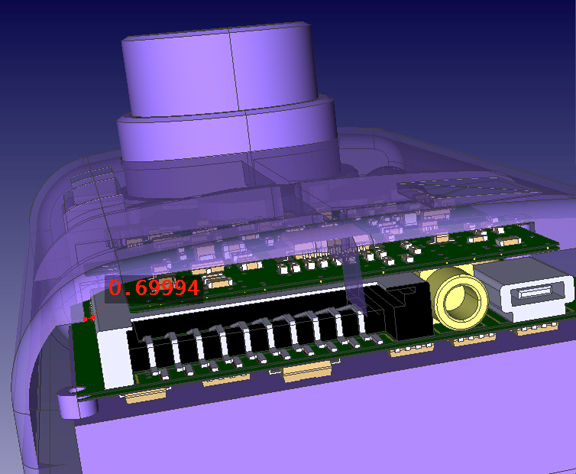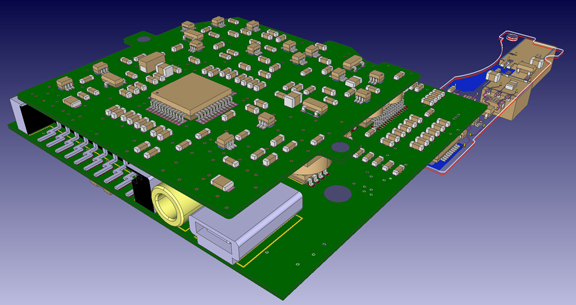
True 3D component shapes are used for collision checks and 3D clearance checks in Zuken CR-8000 2015.1 (image courtesy of Zuken).
Latest News
September 15, 2015
 True 3D component shapes are used for collision checks and 3D clearance checks in Zuken CR-8000 2015.1 (image courtesy of Zuken).
True 3D component shapes are used for collision checks and 3D clearance checks in Zuken CR-8000 2015.1 (image courtesy of Zuken). PCB layout with individual 3D components, created in Zuken CR-8000 2015.1 (image courtesy of Zuken).
PCB layout with individual 3D components, created in Zuken CR-8000 2015.1 (image courtesy of Zuken).As PCB West 2015 (Sep 15-17, Santa Clara) gets underway, PCB software maker Zuken unveiled am upgrade to its PCB design package, CR-8000. The show is also the premiere event for Kent McLeroth, who assumed the CEO post at Zuken in August. An EDA (electronic design automation) veteran with a PLM (product lifecycle management) background, McLeroth believes, “From transportation to aerospace to consumer electronics, today’s integrated products demand an integrated design approach.”
In May, when Zuken released CR-8000 2015, the company’s CTO Kazuhiro Kariya observed, “We launched CR-8000 with a vision that design processes are moving from a traditional PCB-centric approach to a more collaborative 3D product-centric process.” The collaboration with MCAD package users was facilitated via CR-8000 Design Force, which can import typical CAD data used to built the products’ exterior geometry and PCB enclosures. The most recently release, CR-8000 2015.1, is marked by “improved accuracy in layer configuration design work through transfer of layer configuration data between CR-8000 Design Force and Polar Instruments Speedstack [software for designing multi-layer PCB stacks],” according to Zuken’s announcement.
The stackup design and verification with Polar Instruments Speedstack addresses some of the nagging problems in PCB Design, according to McLeroth. He revealed, “I’ve heard customers say 10% of their products are usually found to be not working because of simple connection errors. Some say 10% is a conservative number.” The improved integration of Speedstack is expected to reduce these errors.
The MCAD-ECAD transfer is critical in IoT products, McLeroth pointed out. “With these products, you need better enclosure fitting, whether it’s designed in PTC Creo, Siemens NX, or AutoCAD. We’re seeing a blurring of the line between MCAD and ECAD. Product packaging is becoming more complex, particularly because people need to design them with the enclosures.”
In 2013, Japan-headquartered Zuken opened the SOZO Center in San Jose, California. The center’s name is derived from the Japanese word for “create.” Located in the heart of the Silicon Valley, the center represents the first step in Zuken’s North American expansion strategy.
“The consumer product market used to be driven by Japan,” noted McLeroth. “But it has shifted back to the U.S. Today, it’s driven by companies like Apple, Qualcomm. We want to be closer to where our customers are.”
Also an exhibitor at PCB West, Altium is releasing its PCB design package Altium Designer 16, billed as a major upgrade by the company. The new release is marked by
- an alternative part choice system in the component selection process;
- visual clearance boundaries to analyze the effects of routing decisions in real-time;
- a component placement system.
Zuken is launching an online campaign to let prospective buyers test-drive its CR-8000 software in the cloud. The test is made available through Amazon WS-powered remote desktops preloaded with the software and some sample PCB data. It’s available at www.zuken.com/cr-test-drive.
Subscribe to our FREE magazine, FREE email newsletters or both!
Latest News
About the Author
Kenneth Wong is Digital Engineering’s resident blogger and senior editor. Email him at [email protected] or share your thoughts on this article at digitaleng.news/facebook.
Follow DE





